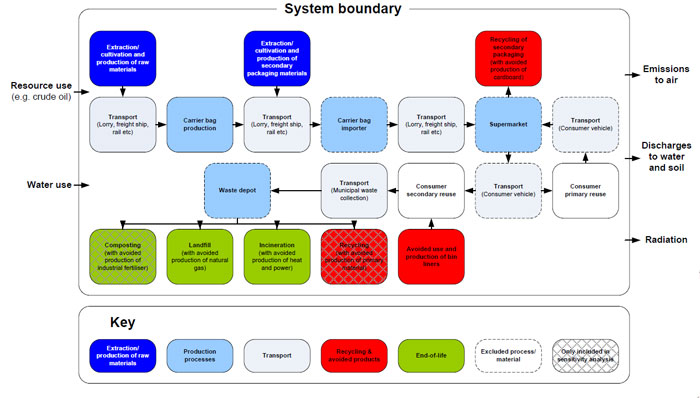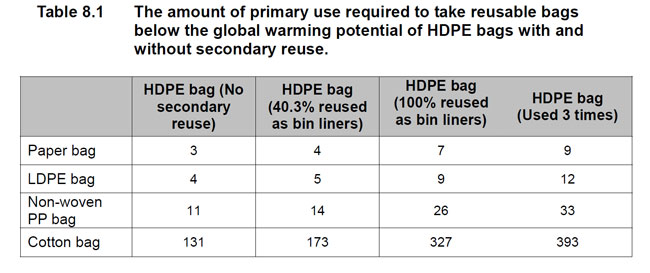As we have reported from time to time, the signature battle in the Green supply chain landscape may just be the plastic grocery bag, with many environmentalists working hard to have the plastics sacks banned, while others argue that in terms of total environmental impact, paper bags are actually worse (see
Plastic Versus Paper Versus Re-Usable - the Great Shopping Bag Smackdown).
Now this general debate has taken a new turn, as a UK government agency focused on improving the environment developed has a draft report that questions the benefits of re-usable grocery bags versus the plastic alternative.
Since the results were reported by various media in recent weeks, the report appears to have been taken down from the Environmental Agency site - perhaps because the agency did not in the end like the report's findings by authors Dr. Chris Edwards and Jonna Meyhoff Fry.
Fortunately, it was captured earlier and still available from other sources. See Life Cycle Assessment of Supermarket Carrier Bags.
If nothing else, the report highlights how truly complicated many environmental issues really are.
The report notes that there are many different types of re-usable grocery bags, which can be made of a surprising number of materials. While traditional plastic bags are made from high-density polyethylene (HDPE), re-usable materials include:
• Biodegradable bags made from a starch-polyester (biopolymer) blend
• "Bags for life” made from low-density polyethylene (LDPE)
• Heavier, more durable bags, often with stiffening inserts made from non-woven polypropylene (PP)
• Cotton bags
We were a bit surprised to hear from the report that the traditional paper grocery bag has basically disappeared from UK grocery stores, while they remain fairly popular in the US - perhaps in part because some shoppers continue to believe they are the more environmentally friendly choice. The heavy duty plastic "bag for life" is also uncommon in the US.
At a high level, obviously the total environmental effectiveness of re-usable bags depends directly on how many times they are re-used.
The report, for example, says that “Whatever type of bag is used, the key to reducing the impacts is to reuse it as many times as possible. The paper, low-density polyethylene (LDPE), non-woven polypropylene and cotton bags should be reused at least three, four, 11 and 131 times respectively to ensure that they have lower global warming potential than conventional high-density polyethylene (HDPE) carrier bags that are not reused.”
If those levels of use per type of material are not reached, the traditional plastic bag turns out to be more environmentally friendly.
Another factor often not considered is that consumers frequently re-used the traditional plastic bags at home for other uses that might otherwise require use of another product, which helps the full lifecycle profile of plastic bags.
“The reuse of conventional HDPE and other lightweight carrier bags for shopping and as bin liners is pivotal to their environmental performance, and reuse as bin liners produces greater benefits than recycling bags,” the study notes. "And reusing a plastic bag just once puts it in the same environmental category as a cotton bag that’s reused 173 times—or, nearly every day for six months."
The researchers used the popular full Life Cycle Analysis (LCA) method to make their comparisons, which winds up with a rather complex total analysis, as shown in the graphic below.

The report also notes the many complexities involved in doing an LCA on bags, citing where the bags are manufactured as just one example, as that impacts the environmental impact to get the bags from origin to point of use.
In total, however, the analysis calculated Greenhouse gas emissions generated from five key processes:
• The extraction/production of raw materials (HDPE, LDPE, PP, paper, starchpolyester blend, etc.)
• The production processes (energy use during the production of the carrier bag)
• Transport (the movement of raw materials to the production site and the finished carrier bag to the supermarket)
• End-of-life (including collection, landfill and incineration)
• Avoided products and recycling (the avoidance of virgin materials through secondary reuse or recycling.
The full report goes into a tremendous amount of detail relative to the environmental impact of a number of different bag types. The chart below well summarizes that detail by comparing the number of times different types of bags had to be re-used to be equivalent with the impact of the traditional plastic bag, under different re-use scenarios for the plastic bag.

Source: Environmental Agency UK, Draft Report
The UK study, however, did not account for the economic and environmental costs of cleaning reusable shopping bags. If that step was factored in, the environmental benefits of reusable bags become even more dicey.
“One of the flaws I see in this study is it doesn’t consider the number of times people have to wash their reusable bags,” said Keith Christman, managing director of plastics market at the American Chemistry Council. “We have found high levels of bacterial contamination in reusable bags, … and once you figure in the hot water, the drying,” most of the supposed environmental gain has gone down the drain, even if the bags are used hundreds of times.
Obviously, Christman is supporting his cause, but it again just shows the complexity required to really do a full LCA on anything.
The "draft" status of the report, and seeming now removal from the agency site, are also causing controversy.
Barry Turner, chief executive of the Packaging and Films Association, which represents plastic bag manufacturers, suggested the report had been “suppressed.” “They [the Environment Agency] have kept it fairly quiet and tried to suppress things,” he said.
“This [report] has dragged on and on. It was a report that could have been done relatively quickly, probably within 12 months but it has gone on for years."
What is your reaction to this grocery bag study? Just how hard is it to really understand the full environmental impact of anything? Let us know your thoughts at the Feedback button below.

TheGreenSupplyChain.com is now Twittering! Follow us at www.twitter.com/greenscm
|